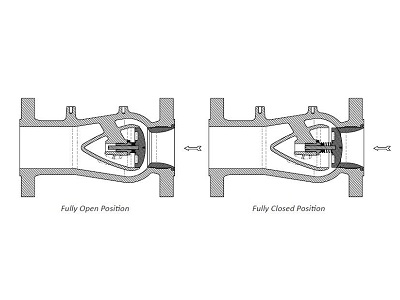Axial-flow check valve should have a streamline shape on the surface of the inner cavity of the valve body, the diversion cover, the valve flap and other flow surfaces, with a rounded front and a sharp back. The fluid is mainly on its surface as layer flow, and there is no or rarely turbulence.
In addition to the functions of a general check valve, the axial flow check valve is also designed with a shock-absorbing spring, and the combined valve seat sealing structure with a hard seal and a soft seal has the effect of noise reduction and shock absorption, which is convenient for users to overhaul on site. The unique axial shuttle structure has the advantages of small flow resistance, large flow coefficient, and small shape size. It is a preferably preferably preferably preferably preferably valve at home and abroad, especially the oil pump outlet. It is suitable for pipeline systems such as oil, gas, water slurry and acidic corrosive media containing H2S+CO2, and the control medium is used in countercurrent.
The axial flow check valve adopts an axial flow shuttle structure in structure, and its valve disc is equipped with a buffer damping spring. When the medium flows downstream, the valve disc opens, the medium circulates through the axial flow channel of the valve body, and the medium is pushed open. When the valve disc is opened, the spring plays a buffering effect, which avoids the impact and vibration between the valve disc and the valve body when the ordinary check valve is opened. When the medium flows in the reverse direction, the valve flap is quickly closed, and the valve flap and the valve seat are closely fitted to prevent the reverse flow of the medium. The combined hard seal and soft seal valve seat structure can effectively reduce the impact noise when the valve disc and the valve seat are fitted. This type of check valve is an ideal product for fluid gathering and transportation network to prevent medium backflow and eliminate noise and vibration.
1. The type of axial flow check valve
Axial flow check valve can be divided into sleeve shape, disc shape, ring disc shape and other forms according to the structure of its disc.

2. Structural characteristics of axial flow check valve
1. The shock-absorbing spring is designed to avoid vibration and noise caused by the direct impact between the disc and the valve body when the ordinary check valve is opened.
2. The valve seat adopts a combined sealing structure with hard sealing and soft sealing, which has the effect of noise reduction and shock absorption, which is convenient for users to overhaul on site.
3. Compact structure, beautiful appearance and small size.
4. Unique axial flow shuttle structure, small flow resistance and large flow coefficient.
3. Working principle of axial flow check valve
The opening and closing of the valve disc is determined by the pressure difference between the inlet end and the outlet end of the valve. When the pressure at the inlet end is greater than the sum of the pressure at the outlet end and the spring force, the valve flap opens. As long as there is a pressure difference, the valve flap is always open, but the degree of opening is determined by the pressure difference. When the sum of the pressure at the outlet end and the elastic force of the spring is greater than the pressure at the inlet end, the valve flap is closed and remains closed. Since the opening and closing of the valve disc is in a dynamic force balance system, the valve runs smoothly, without noise, and the water hammer phenomenon is greatly reduced.
If the fluid flow pressure cannot support the valve at a large opening and maintain a stable opening position, the valve disc and related moving parts may be in a state of continuous vibration. In order to avoid premature wear, noise or vibration of moving parts, the size of the check valve is selected according to the fluid state.
The disc of the axial flow check valve is light in weight, which can reduce the friction force on the guide surface and return to the seat quickly. The low-mass, low-inertia disc travels a short stroke and contacts the seat surface with minimal impact. This can reduce damage to the seat sealing surface and prevent seat leakage.
Axial flow check valve closes quickly, without impact, the valve disc with small mass and low inertia passes through a short stroke and touches the valve seat surface with a very small impact force, which can keep the valve seat sealing surface in good condition and avoid damage. More importantly, it minimizes the formation of pressure fluctuations and ensures system safety.
 WENZHOU WEITUO VALVE CO., LTD.
WENZHOU WEITUO VALVE CO., LTD.